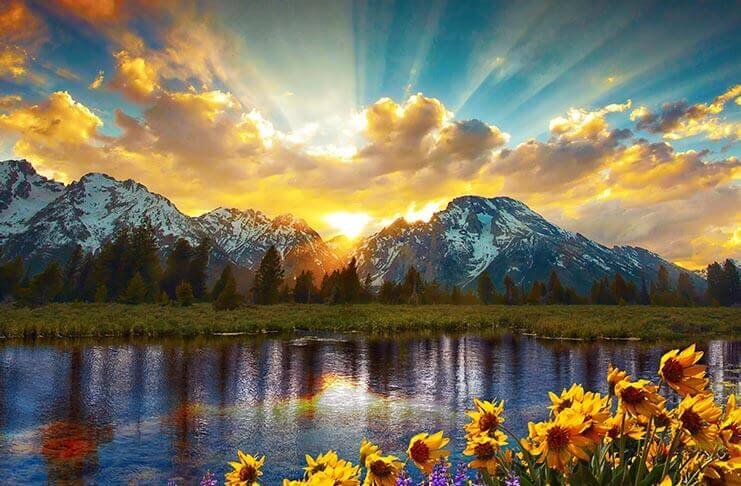Landscape photography offers a unique opportunity to capture the beauty and grandeur of the natural world. Whether you’re photographing a majestic mountain range, a serene lake, or a sprawling desert, the right techniques can help you create stunning images that truly reflect the scene’s beauty. Here are some expert tips to enhance your landscape photography and produce breathtaking results.
1. Plan Your Shoot
Preparation is key to successful landscape photography. Planning your shoot can help you make the most of the natural light and weather conditions.
- Research Locations: Use online resources, maps, and local guides to find interesting landscapes. Visit the location beforehand if possible, to scout the best spots and angles.
- Check the Weather: Good weather conditions can significantly impact your photos. Look for clear skies, dramatic clouds, or interesting lighting conditions. Apps and websites that provide weather forecasts and sunrise/sunset times can be valuable tools.
- Golden and Blue Hours: The best times for landscape photography are during the golden hour (shortly after sunrise and before sunset) and the blue hour (the period just before sunrise and after sunset). These times provide soft, warm light and vibrant colors.

2. Master Composition Techniques
Composition is crucial in landscape photography, as it helps guide the viewer’s eye and create a balanced image.
- Rule of Thirds: Divide your frame into nine equal parts using two horizontal and two vertical lines. Place key elements of your scene along these lines or at their intersections to create a more balanced and engaging composition.
- Leading Lines: Use natural lines such as rivers, roads, or pathways to lead the viewer’s eye into the scene and towards the main subject.
- Foreground Interest: Include elements in the foreground to add depth and dimension to your photos. This can help create a sense of scale and draw the viewer into the scene.
- Framing: Use natural elements like trees, rocks, or arches to frame your main subject and add context to your image.
3. Use the Right Equipment
Choosing the right equipment and settings can make a significant difference in the quality of your landscape photos.
- Camera and Lenses: A DSLR or mirrorless camera with a wide-angle lens (e.g., 16-35mm) is ideal for capturing expansive landscapes. A tripod is essential for stabilizing your camera and preventing camera shake, especially in low light conditions.
- Filters: Consider using polarizing filters to reduce glare and enhance colors, or neutral density filters to control exposure and capture motion blur in flowing water or clouds.
- Camera Settings: Shoot in RAW format to retain more detail and have greater flexibility in post-processing. Use a small aperture (e.g., f/8 to f/16) for a greater depth of field and ensure both the foreground and background are in sharp focus.
4. Pay Attention to Lighting
Lighting plays a crucial role in landscape photography and can dramatically affect the mood and tone of your images.
- Soft Light: Overcast days can provide soft, diffused light that reduces harsh shadows and highlights, making it easier to capture details in the scene.
- Backlighting and Side Lighting: Experiment with backlighting or side lighting to create dramatic effects and emphasize textures. This can add depth and dimension to your photos.
- Shadow Play: Use shadows to create contrast and visual interest. Shadows can highlight textures and shapes in the landscape.
5. Focus on Details and Post-Processing
Attention to detail and careful post-processing can elevate your landscape photos from good to great.
- Manual Focus: Use manual focus to ensure precise control over the sharpness of your image, especially in scenes with complex depth.
- Bracketing: Take multiple shots at different exposures (bracketing) to capture a wider dynamic range. This can be useful for high-contrast scenes and creating HDR images.
- Editing: Use photo editing software to enhance your images. Adjust exposure, contrast, and color balance to bring out the best in your photos. Be careful not to over-edit; aim for natural-looking enhancements that preserve the scene’s authenticity.
6. Experiment and Be Patient
Great landscape photography often requires experimentation and patience.
- Try Different Angles: Explore various angles and perspectives to find the most compelling composition. Sometimes a slight change in position can make a big difference.
- Wait for the Right Moment: Landscape photography can require waiting for the perfect lighting conditions or weather. Be patient and willing to return to a location multiple times to capture the best shot.
Conclusion
Capturing stunning landscape photos involves a blend of planning, technique, and creativity. By mastering composition, using the right equipment, and paying attention to lighting and details, you can create images that truly reflect the beauty of the natural world. Remember, the key to great landscape photography is to experiment, be patient, and enjoy the process of capturing the beauty around you. With these tips, you’ll be well on your way to producing breathtaking landscape images that inspire and captivate.










